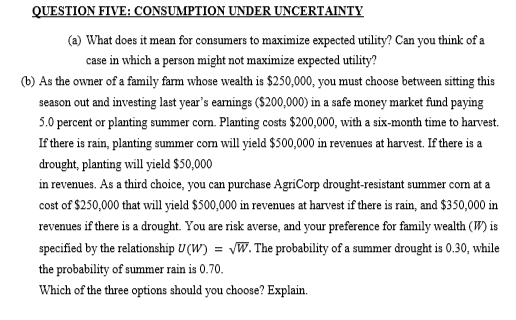QUESTION FIVE: CONSUMPTION UNDER UNCERTAINTY (a) What does it mean for consumers to maximize expected utility? Can you think of a case in which a person might not maximize expected utility? (b) As the owner of a family farm whose wealth is $250,000, you must choose between sitting this season out and investing last year's earnings ($200,000) in a safe money market fund paying 5.0 percent or planting summer com. Planting costs $200,000, with a six-month time to harvest. If there is rain, planting summer corn will yield $500,000 in revenues at harvest. If there is a drought, planting will yield $50,000 in revenues. As a third choice, you can purchase AgriCorp drought-resistant summer corn at a cost of $250,000 that will yield $500,000 in revenues at harvest if there is rain, and $350,000 in revenues if there is a drought. You are risk averse, and your preference for family wealth (W) is specified by the relationship U(W) = √W. The probability of a summer drought is 0.30, while the probability of summer rain is 0.70. Which of the three options should you choose? Explain.
QUESTION FIVE: CONSUMPTION UNDER UNCERTAINTY (a) What does it mean for consumers to maximize expected utility? Can you think of a case in which a person might not maximize expected utility? (b) As the owner of a family farm whose wealth is $250,000, you must choose between sitting this season out and investing last year's earnings ($200,000) in a safe money market fund paying 5.0 percent or planting summer com. Planting costs $200,000, with a six-month time to harvest. If there is rain, planting summer corn will yield $500,000 in revenues at harvest. If there is a drought, planting will yield $50,000 in revenues. As a third choice, you can purchase AgriCorp drought-resistant summer corn at a cost of $250,000 that will yield $500,000 in revenues at harvest if there is rain, and $350,000 in revenues if there is a drought. You are risk averse, and your preference for family wealth (W) is specified by the relationship U(W) = √W. The probability of a summer drought is 0.30, while the probability of summer rain is 0.70. Which of the three options should you choose? Explain.
Chapter7: Uncertainty
Section: Chapter Questions
Problem 7.7P
Related questions
Question

Transcribed Image Text:QUESTION FIVE: CONSUMPTION UNDER UNCERTAINTY
(a) What does it mean for consumers to maximize expected utility? Can you think of a
case in which a person might not maximize expected utility?
(b) As the owner of a family farm whose wealth is $250,000, you must choose between sitting this
season out and investing last year's earnings ($200,000) in a safe money market fund paying
5.0 percent or planting summer corn. Planting costs $200,000, with a six-month time to harvest.
If there is rain, planting summer corn will yield $500,000 in revenues at harvest. If there is a
drought, planting will yield $50,000
in revenues. As a third choice, you can purchase AgriCorp drought-resistant summer corn at a
cost of $250,000 that will yield $500,000 in revenues at harvest if there is rain, and $350,000 in
revenues if there is a drought. You are risk averse, and your preference for family wealth (W) is
specified by the relationship U(W) = √W. The probability of a summer drought is 0.30, while
the probability of summer rain is 0.70.
Which of the three options should you choose? Explain.
Expert Solution
This question has been solved!
Explore an expertly crafted, step-by-step solution for a thorough understanding of key concepts.
This is a popular solution!
Trending now
This is a popular solution!
Step by step
Solved in 5 steps with 3 images

Knowledge Booster
Learn more about
Need a deep-dive on the concept behind this application? Look no further. Learn more about this topic, economics and related others by exploring similar questions and additional content below.Recommended textbooks for you

